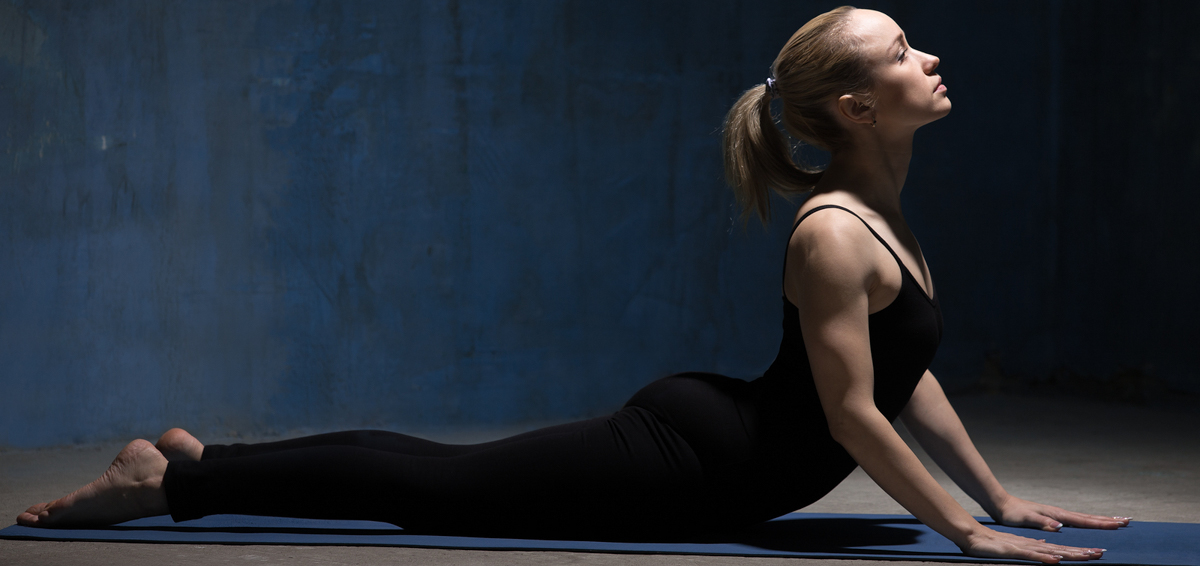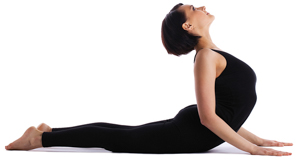The Twelve Basic Yoga Poses

In Sivananda Yoga, the twelve basic yoga poses form the foundation for a complete and balanced practice. These asanas benefit the physical body by strengthening the muscles, improving balance, increasing flexibility, massaging the internal organs and creating suppleness of the spine. Mentally, they optimize the functioning of the brain and enhance the powers of concentration. With consistent practice, the sequence becomes a flowing meditative exercise that activates the chakras and increases the flow of prana (vital energy) throughout the entire body.
Theses asanas are always practiced after the body has been prepared through initial prayers, breathing exercises (Kapalabhati and Anuloma Viloma) and the Sun Salutation. Each posture consists of three parts: correctly coming into the pose; holding the pose with proper breathing; and coming out of the pose in a safe way. Variations and more advanced versions are incorporated as the yoga practitioner progresses in their ability.
Remember that the twelve basic yoga poses are always performed in order for a reason. Based on anatomical science, the exact progression of inversions, compressions, extensions, stretches, twists and joint-opening movements encourage the body into its optimal state of health and alignment.
1. Headstand (Sīrsāsana)

Known as the King of Asanas, the headstand is the first of the twelve basic yoga poses. It is easily one of the most beneficial postures for the human body. The complete vertical inversion of this pose effortlessly invites fresh blood, oxygen and nutrients to the heart and brain. Moreover, it improves mental capacity, releases any pressure in the lower back and encourages circulation.
2. Shoulderstand (Sarvāngāsana)

Yoga practitioners come out of a shoulderstand feeling incredibly renewed and refreshed! Providing similar benefits to those of the Headstand, this posture also stretches the neck, activates the thyroid glands, detoxifies the body and allows deep breathing by restricting the use of the top of the lungs.
3. Plough (Halāsana)

Continuing the effects of the Shoulderstand, the Plough pose activates and massages the internal organs by putting gentle pressure on the abdomen. It also promotes flexibility of the spine and stretches the back and shoulders, leaving the entire body feeling uplifted and rejuvenated.
4. Fish (Matsyāsana)

To counteract the stretch of the neck and spine in the previous two poses, the Fish now arches them back while expanding the chest. This allows an influx of fresh oxygen to enter the body. It should always be practiced directly after the Shoulderstand series in order to reap its full benefits and correct the body’s alignment.
5. Sitting Forward Bend (Paschimottānāsana)

Together with the Headstand and the Shoulderstand, the Seated Forward Bend is said to be one of the three poses required for perfect health. This posture stretches the hamstrings, lengthens the spinal column, calms the nervous system, activates the internal organs and keeps the waist and abdomen trim and toned.
6. Cobra (Bhujangāsana)

“You’re only as young as your spine is flexible.” The Cobra pose is a dynamic backward stretch for the upper body and spine. In addition to being incredibly empowering, this posture strengthens the back muscles, tones the abdominals, activates the internal organs and aids in the elimination of wastes from the body.
7. Locust (Śalabhāsana)

The leverage and lift of the body in the Locust requires a higher degree of lower body strength than other asanas. Being a backward bend, it improves the functioning of the entire digestive system and tones the core. It also strengthens the muscles of the back and the legs.
8. Bow (Dhanurāsana)

The Cobra and the Locust together become the Bow Pose, a powerfully effective posture for a supple spine and a strong back. The weight of the body on the abdomen reduces excess fat, keeps the internal organs healthy and is a boon for the reproductive system.
9. Half Spinal Twist (Ardha Matsyendrāsana)

Named after the yogic sage Matsyendra, this posture does wonders for the body by laterally rotating the spinal column and lubricating each vertebra. As with all twisted poses, toxins are encouraged out of the body, digestion is improved and the internal organs are gently massaged into their natural positions.
10. Crow (Kakāsana)

The Crow is the first of many arm balancing postures in Yoga. It not only strengthens the shoulders, arms and wrists, but also invites deep breathing and substantially improves the powers of concentration. Mental focus and attention is the key to achieving this pose, even more so than physical strength.
11. Standing Forward Bend (Pāda Hastāsana)

The standing forward bend, similar to the seated version, improves flexibility and contributes to a more toned mid-section. Moreover, the gentle and comforting inversion of the upper body calms the central nervous system, relaxes the mind, relieves stress and eliminates fatigue.
12. Triangle (Trikonāsana)

This standing posture forms the final of the twelve basic yoga poses. Like the half spinal twist, it is a lateral spinal stretch that regulates the digestive system and tones the waist. Furthermore, it improves balance, augments the powers of concentration and makes the legs long, strong and defined.

Never did yoga myself but i may consider it. Consice article you have here 🙂
Thanks Antonis!
Ok – at first those poses made me really scared, but I’ve heard it can be relaxing. Great info. JoEllen
Ha ha! Not scary at all!
I’ve been practicing yoga for my back pains and it work. Head stands for me are impossible. I get to a point were I don’t see much progress. Remember that I just watch videos and have no instructors. What do you recomend me to acomplish a bit more progress into my workouts? Thanks in advance.
Finding a good instructor that you’re comfortable with is the first step, Mike. After that, make it a point to practice regularly.
I’m glad you find that yoga is helping you!
I tried Yoga once and it is really tough, sweat like a dog and never ever thought that Yoga can be so taxing. Yoga is definitely a good exercise for both body and mind, I will wanna pick it up again.
Good idea, Axton. Let me know how it goes!
This is just what I need. I recently read about a 59 year old who looked like she was in her 30+ and she said one of the reasons for her youthfulness was that she did yoga everyday. A doctor had also said that stretching your muscles increases your life expectancy. So I really want to start yoga. its great that you have included pictures. Although some of these look too advanced for me. But hopefully one day I will be able to do them all. Wish me luck! Thank you for this!
You’re welcome Stella, all the best for your practice!
I liked JoEllen’s comment that the poses made her scared! I can certainly understand why!
I did some yoga when I was young (many years ago), and found it to be absolutely transforming. My body is not naturally flexible, so yoga definitely helped that. Though I amused my yoga classmates when I would react to the teacher’s instructions, “Now put your foot above your head.” I would laugh hysterically.
But, may I ask, I’m overweight, 63, recovering from knee surgery (patella tendon repair), and very, very stiff. What type of yoga and poses should I use to get started?
Thanks
Roger
Because of your recent injury, I recommend you start regular sessions under the guidance of an instructor, who can show you modifications on all the poses. With consistent practice, especially incorporating Sun Salutations, you’ll find that stiffness disappears and the body becomes stronger and more limber.
Happy practising, Roger!
I feel like all yoga can be quite scary at the start, but it really is very rewarding when you continue to practice. I very much enjoyed your commentary on each move. It’s important to be able to target areas while practicing yoga. Definitely a great read for a beginner like myself!
Glad you enjoyed it, Ash!
Great article, I agree on the amazing health benefits of all these asanas. I have to disagree about the sirsasana being a basic pose. Headstand is not easy for a beginner, since it requires great control of your body and very strong core. Kakasana also takes some time to master as it’s again about learning to control your body and balancing your weight.
I would rather start with practising Surya Namaskar daily, as it will give you a great basis control, before advancing to some of these poses.
Keep in mind that these are the 12 BASIC poses, not 12 BEGINNERS poses.
In a beginners Sivananda session, Sirsasana is usually not practiced and Kakasana is replaced by the Tree Pose or another simpler balancing posture. An advanced session would hence incorporate more challenging variations of the above 12 basic poses, such as Headstand in Lotus pose or the Peacock Pose.
Think of these 12 as a framework with which you can practice simpler or more advanced variations and substitutions.
And yes, Surya Namaskar is a must!
I’ve always been fascinated by yoga, although I didn’t get the chance to learn. I like the fact that it develops both mind and physical at the same time. I have lower back pain and stiff necks. From your article, I think the Bow posture may be the best for me. Do I need to do some warm up first, or can I get in to the posture directly?
A warm up is always a good idea, Kenny. Keep in mind that the Sun Salutation is the perfect warm up for the 12 Basic Poses, so make sure that you do that at the beginning of your practice after your breathing exercises.
I have always wanted to do yoga, and keep thinking I will take the yoga class at the gym. Now I am thinking I need to start at home first! These poses look hard! I need a lot of stretching and a lot more flexibility. Do these poses take a little while to master? Can anyone do them if they stick with yoga, and work at the stretching, etc? I would love to be able to do all of them 🙂 They also have such great benefits!
It’s not about how far you can stretch. It’s how you feel in the pose, even if you’ve stretched just a few inches!
And yes, anyone can do them with regular and consistent practice. Remember that yoga is for everyone, but not all poses are suited for each individual. Practicing under the guidance of a teacher will help you learn which poses are best for your body.
Enjoy the benefits!
Keeping this, need a printout of it to practice everyday!! Haha the simplicity of this is awesome and feel like I have learned a ton. Thanks Andrea. Going to have to look up how to say those real yoga names.
Wonderful! Let me know if you need any help!
Hi,
Thanks for such useful piece of information.
Just need your suggestion regarding how to do these yoga asans like every asan has to be done only once right…and we have to repeat these 12 asans everyday right for good results?
Additionally I have migrane,spondelitis and slip disk problem also…so just need your suggestion like do I need to do all these asans or just skip any?
Hi there Apoorvaa!
Yes, the 12 asanas are to be done one-by-one and in sequence during each session.
Some or all of these poses can be modified or skipped altogether if you have underlying medical conditions. In your case, migraines, a slipped disc and spondylitis may be contraindications for many yogic postures. This is why it would be best for you to practice under the guidance of a teacher who can show you specific modifications and alternatives.